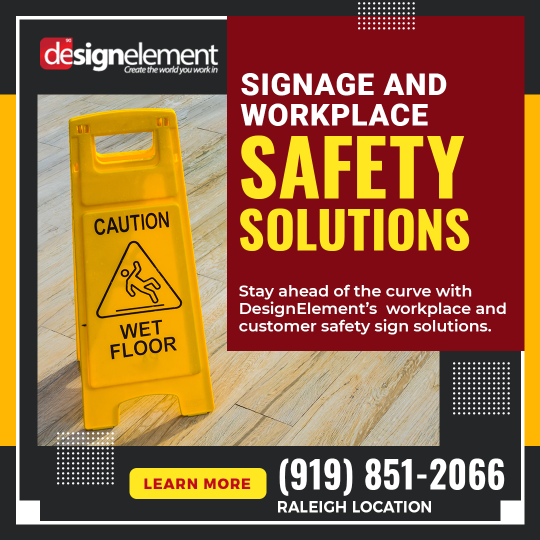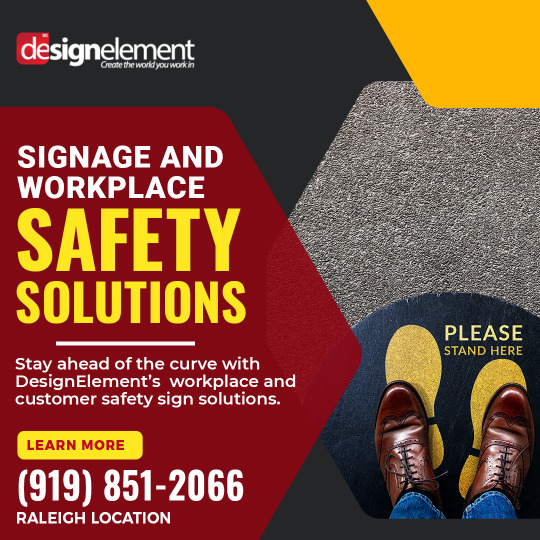Keeping employees and customers safe is a priority for Raleigh, NC, businesses. One of the ways that companies can promote safety at their facilities is by investing in safety signs. An office will likely post different safety warnings than a factory or a restaurant, but all types of businesses can benefit from installing safety signage that is relevant to their industry.

Safety signs perform a threefold function — cautioning, notifying, and guiding. These signs call attention to real or potential safety hazards that customers and employees need to be aware of in order to avoid injury. Most industries are required to post certain types of safety signage.
It is essential that safety signs feature a clear, easy-to-read design. If a safety sign can not be read quickly and if the sign’s content is not clear in its warning, then the sign will not be effective at preventing accidents. A skilled sign company in Raleigh, NC, will be able to design and produce customized safety signage that harmonizes with the client’s brand identity while still complying with federal, state, and local requirements.
The federal regulatory agency that is responsible for establishing effective safety guidelines is the Occupational Safety and Health Administration or OSHA. In a regulation entitled “Specifications for accident prevention signs and tags,” OSHA outlines classifications of safety signs as follows:
- Danger signs – “All employees shall be instructed that danger signs indicate immediate danger and that special precautions are necessary.”
- Caution signs – “Caution signs shall be used only to warn against potential hazards or to caution against unsafe practices. All employees shall be instructed that caution signs indicate a possible hazard against which proper precaution should be taken.”
- Safety instruction signs – “Safety instruction signs shall be used where there is a need for general instructions and suggestions relative to safety measures.”
- Biological hazard signs – “The biological hazard warning shall be used to signify the actual or potential presence of a biohazard and to identify equipment, containers, rooms, materials, experimental animals, or combinations thereof, which contain, or are contaminated with, viable hazardous agents.”
Safety signs should be posted in places where people can easily and clearly see them. High visibility is a key consideration when choosing the location in which to place a safety sign. Also, make sure that the sign is placed within close proximity to the relevant hazard or potential hazard. This practice will help to prevent people from becoming confused or misunderstanding the sign’s message.
Signage commonly required by OSHA includes:
- Exit signs
- Fire signs
- First Aid station signs
- No smoking signs
- Personal Protective Equipment (PPE) signs
- High voltage signs
- Machinery signs
- Slip and fall signs
- Low overhead signs
In terms of a safety sign’s content, OSHA provides the following instructions: “The wording of any sign should be easily read and concise. The sign should contain sufficient information to be easily understood. The wording should make a positive, rather than negative suggestion and should be accurate in fact.”
Color is a central part of safety sign design. Because color is such a powerful communication tool, OSHA has specific guidelines relating to the use of color in certain safety signs. Danger signs, for instance, should be red, black, and white. Regarding caution signs, OSHA states, “The standard color of the background shall be yellow; and the panel, black with yellow letters. Any letters used against the yellow background shall be black.” Similar instructions are given about the colors used in safety instruction signs. “The standard color of the background shall be white; and the panel, green with white letters. Any letters used against the white background shall be black.”
Finally, businesses must make sure that their safety signs are not hazards in and of themselves. According to OSHA, “All signs shall be furnished with rounded or blunt corners and shall be free from sharp edges, burrs, splinters, or other sharp projections. The ends or heads of bolts or other fastening devices shall be located in such a way that they do not constitute a hazard.”
DesignElement of Raleigh, NC, is the premier choice for signage services in the local area. The team is highly experienced and produces complete sign packages for projects of any size and scope. With a broad knowledge of materials, manufacturing processes, and code compliance, DesignElement is an indispensable partner for Raleigh, NC, businesses.

To learn more about sign design in Raleigh, NC, contact DesignElement of Raleigh by phone at (919) 851-2066.
source https://designelement-us.com/press-releases/raleigh-nc-sign-company-explains-how-signs-promote-safety/



No comments:
Post a Comment